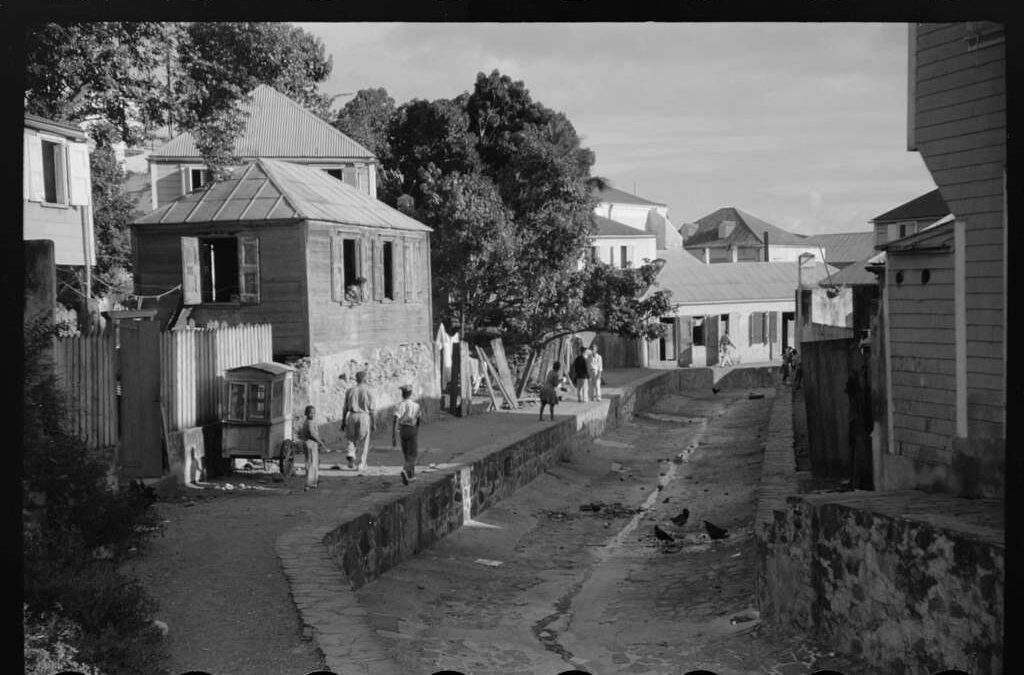Located on Main Street in downtown Charlotte Amalie is the grandest of all island homes. A towering and sprawling masonry building that still stands majestic and firm over 200 years since its birth. Possessed by some of the richest, most powerful men in the Danish West Indies, this piece of architecture is the grand dame of Charlotte Amalie. The building is located at 20 Queens Street (20 Dronningens Gade).
(Currently she is being treated as a concubine by one of the surliest and ugliest of sirs, the Virgin Islands Government. What a tragedy to put this fine lady in the hands of such an inartful and abusive master.)
But we are not here to discuss the brilliant staircases, grand halls and stately rooms of this lovely lady. Instead, we’ll walk around to her luscious and ample back side. Beyond the graceful walls of the main house, you’ll find a homely and unassuming little lass. She’s a humble and homely little 1-story building surrounded by imposing, multi-story buildings. (I’ll go ahead and cease with the female personification now.) From the street this single-story building looks like you almost would have to duck to walk inside.
This building is located at 13 Wimmelskafts (known affectionately as “13W”), which is the Danish street address. When 13W was first constructed, it was part of the large estate previously mentioned at 20 Queens Street. The building was the slaves’ quarters for the merchants that owned that estate.
The first family of note to call the property home was the de Bretton Family. The de Brettons were wealthy merchants and traders originally from France. The patriarch of the family, Jean comte de Bretton, was expelled from France by Louis XIV in 1685 when the Edict of Nantes was revoked. The family sought refuge in the Danish Kingdom. His descendants then moved to the Virgin Islands.
This family was part of the merchant class in St. Thomas. The merchant class in the Virgin Islands enjoyed the thriving international trade and cosmopolitan atmosphere for many decades. The island was a free port and neutral harbour for any and all countries to engage in friendly commerce.
But eventually 2 events/non-events caused the decline of St. Thomas as a commercial center:
1. Emancipation of 1848
With the abolition of slavery in 1848, many of the local manufacturing and farming interests suffered. Workers (read former slaves) were no longer bound to work for a specific family or business. And labor became more expensive in absolute terms.
2. Peace
St. Thomas benefitted greatly during times of war and unrest in other parts of the world. It’s status as a free port and neutral port ensured a bustling economy. During European wars, the US Revolutionary War and US Civil War, St. Thomas enjoyed prosperity. When peace ruled, St. Thomas declined.
By the late 1800’s and early 1900’s, St. Thomas had lost a bit of its mojo. It was during this time that 13 Wimmelskafts was separated from the main estate at 20 Queens Street. A road was built that cut the umbilical cord and 13W had to stand on her own – she became housing for local workers and later a commercial space.
Over the years 13W was a sporting good store, nursing school, daycare, government offices and a beauty salon. With each successive change the building went deeper into disrepair and neglect.
By 2020 the roof and gutters had small trees and vegetation growing out of them, a massive palm tree had grown into one of the walls, water leaked through holes, and rats were the main tenants of the building.
About this time in 2020 the property was bought by a local couple and lovingly restored brick-by-brick and stone-by-stone. Almost every piece of stone, brick and shell was saved and used in the restoration.
The property now houses a lovely cafe and manufacturing business making long-forgotten recipes and products including rum balls, coffee, pepper sauce and numerous other authentic goods.
When you visit, a few things to notice are:
1. The double, brick oven
As far as is currently known, it is the only one of its kind in the Caribbean. The double oven was a necessity due to the large number of people living at 13W and the need to serve 10-20 people at a time. The diet of the inhabitants would have been vegetables, fruits and some fish and pork. And all of the meals were cooked right in those ovens.
2. The backyard
The slaves and servants of 13W were permitted small gardens and small livestock (probably chickens) in the backyard. The backyard would also have been where they did laundry, socialized and rested.
3. The saltwater well
Freshwater can be a bit scarce at times in the islands. This saltwater well promised plentiful water for washing dishes, clothes and tired bodies.
4. The architecture
13 Wimmelskafts was made from “rubble construction”. Which is exactly as it sounds, the walls were made of whatever useful materials they could find back then – brick, rock and shells. The ceilings were made without any fasteners, only wood joints that fit expertly together. The builders would have been the slaves who were taught their carpentry skills by European tradesmen.
The mortar used in the rubble masonry was an odd mixture of molasses, horse hair and lime. Many visitors to 13W have taken to licking the stone because apparently you can taste the sweet notes of the molasses. Proceed at your own risk. 🙂
5. The gut
If you are standing in the street and looking at the front of the building and you look to the left there is a massive gut and culvert. If you follow that gut to its origin it will take you up the top of St. Peter Mountain. During heavy rains the gut becomes a raging river and can overflow the walls and flood all the buildings in the area in Charlotte Amalie.
6. The artifacts, memorabilia and artwork
Today, 13W displays a wide assortment of St. Thomas and Danish-related artifacts and bric-a-brac. You’ll find old maps, coins, authentic documents and writings from the island’s past and original artwork by none other than the famed Camille Pissaro who was born and raised just a few hundred feet away.
When visiting St. Thomas, and in particular Charlotte Amalie, you must stop by to visit 13 Wimmelskafts for an authentic experience of the island’s past. To learn more about the island’s history and get a guided tour of 13 Wimmelskafts please check out our St. Thomas walking tour.


